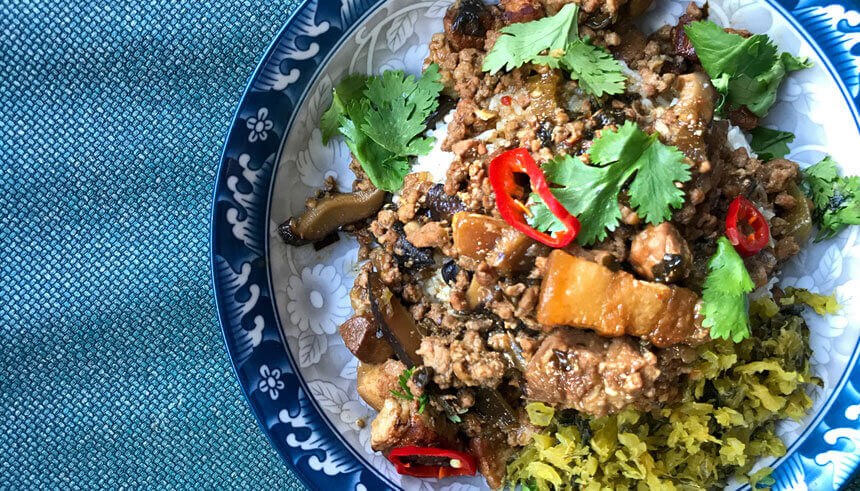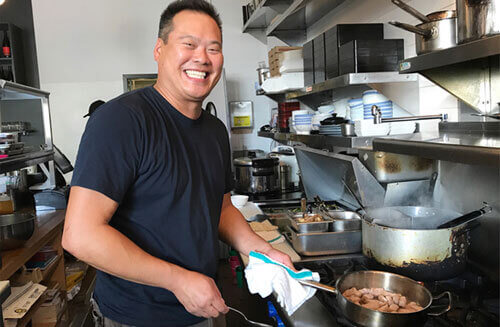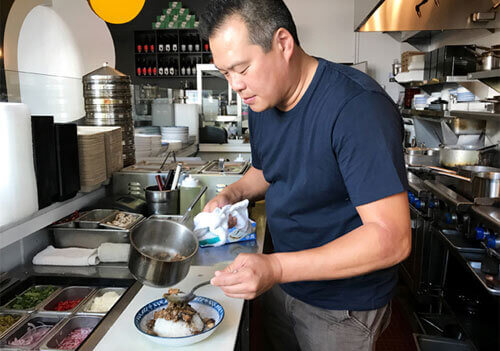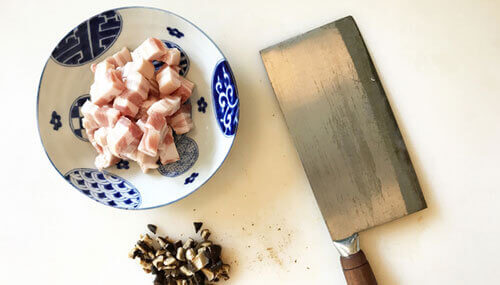East West Lifestyle
Recipes of Asia: Taiwanese Sunday Gravy by Little Fatty
By Clarissa Wei

Foodie Clarissa Wei invites you to try Taiwan’s favorite comfort food.
If you’re Taiwanese, lu rou fan is one of those classic dishes you grew up loving but never quite really knew how to articulate. Fundamentally, it’s ground pork over rice. Technically, it’s a slow-braise of the fattiest cuts of pork marinated in a wonderfully potent sauce. It’s supposed to melt in your mouth; it’s the quintessential Taiwanese comfort food dish.
This particular recipe is from Little Fatty in the Mar Vista neighborhood of Los Angeles. They’re a Taiwanese specialist and one of the few on the Westside. Behind the helm is Chef David Kuo. Born and raised in the U.S., Kuo is of Taiwanese descent and has designed Little Fatty to be a reflection of his heritage.

“Lu rou fan is one of Taiwan’s national dishes.”
Opened in 2016, Little Fatty is a love letter to the dishes that Kuo grew up with. Not all the dishes are Taiwanese, which is what makes his concept so nuanced. While some of them are, like the baos, the pork chop, and the noodle soups, others are simply Chinese classics that he grew up with here in Southern California (Hainan chicken, orange chicken, egg rolls and walnut shrimp).
The lu rou fan here, though, is a classic and an essential dish to try.
“We use kombu to bring out natural umami, and fish sauce and hoisin,” Kuo says. “Sambal is also crucial, along with five-spice powder.”
He has renamed the lu rou fan to Taiwanese Sunday gravy, a reference to the meat sauces typically whipped up by Italian grandmothers on the weekends. There is, of course, nothing Italian about Kuo’s Sunday gravy. The vernacular was simply employed in order to communicate the fundamentals of the dish to Little Fatty’s mostly non-Taiwanese audience. Those fundamental elements: that it’s comfort food, that’s it’s a culinary icon, and that it’s the best of home cooking.
“Lu rou fan is one of Taiwan’s national dishes,” Kuo says. “Similar to Italian Sunday gravy, you spend all Sunday stirring the pot and your grandmother is making it, is tasting it, all day.”

His version is a slight modification of what’s typical in Taiwan, and you can get it served over either rice or pasta, the latter of which is atypical but such creativity is what makes Little Fatty unique from all the Taiwanese purists in town.

Taiwanese Sunday Gravy
Cooking time: 3 hours
Serves: 3
Ingredients:- 1 lb ground pork
- 1 lb cubed pork butt
- 1 lb cubed pork belly
- ¼ cup shiitake mushrooms
- 1 large strip of kombu seaweed
- ½ cup shallots
- 2 cloves of garlic
- 2 tbsp low-sodium soy sauce
- 2 tbsp fish sauce
- Dash of sesame oil
- 2 tsp hoisin sauce
- 2 tsp sambal sauce
- 2 tbsp Shaoxing cooking wine
- 2 tbsp kecap manis (Indonesia sweet soy sauce)
- 1 tsp five-spice powder
- Chicken stock to cover
- Soak the kombu and shiitake mushrooms in hot water.
- After 10 minutes, dice the shiitake mushrooms and kombu.
- Mince the garlic and shallots.
- In a large bowl, measure and combine all the liquids. Set aside.
- In a large pot, brown all the meat in two batches over medium heat.
- In a separate pan, sweat shallots, garlic, and mushrooms for 5 minutes. Then combine them with meat pot.
- Add the liquids and spices.
- Add enough chicken stock to cover the meat mixture by ½ inch.
- Bring to boil, then simmer for 2 hours, stirring every 20 minutes.
- Serve with steamed rice and pickled mustard greens, and garnish with cilantro.
Little Fatty: 3809 Grand View Blvd, Los Angeles, CA 90066

